Intravital imaging of tumor apoptosis with FRET probes during tumor therapy
- PMID: 19543775
- PMCID: PMC5987252
- DOI: 10.1007/s11307-009-0235-y
Intravital imaging of tumor apoptosis with FRET probes during tumor therapy
Abstract
Purpose: The aim of the study is to dynamically and non-invasively monitor the apoptosis events in vivo during photodynamic therapy (PDT) and chemotherapy.
Procedures: A FRET probe, SCAT3, was utilized to determine activation of caspase-3 during tumor cell apoptosis in mice, induced by PDT, and cisplatin treatments. Using this method, dynamics of caspase-3 activation was observed both in vitro and in vivo.
Results: Analysis of the fluorescent missions from tumor cells indicated that the caspase-3 activation started immediately after PDT treatment. In contrast, the caspase-3 activation started about 13 and 36 h after cisplatin treatment in vitro and in vivo, respectively.
Conclusions: FRET could be used effectively to monitor activation of caspase-3 in living organism. This method could be used to provide rapid assessment of apoptosis induced by anti-tumor therapies for improvement of treatment efficacy.
Figures
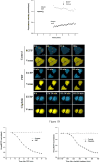

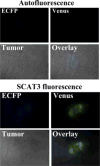
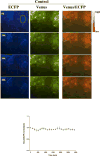
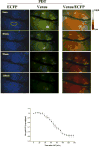
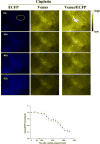
Similar articles
-
Detection of caspase-3 activation in single cells by fluorescence resonance energy transfer during photodynamic therapy induced apoptosis.Cancer Lett. 2006 Apr 28;235(2):239-47. doi: 10.1016/j.canlet.2005.04.036. Epub 2005 Jun 14. Cancer Lett. 2006. PMID: 15958279
-
Single cell FRET imaging for determination of pathway of tumor cell apoptosis induced by photofrin-PDT.Cell Cycle. 2006 Apr;5(7):729-34. doi: 10.4161/cc.5.7.2630. Epub 2006 Apr 1. Cell Cycle. 2006. PMID: 16627992
-
Dynamic monitoring of apoptosis in chemotherapies with multiple fluorescence reporters.Mol Imaging Biol. 2009 May-Jun;11(3):213-22. doi: 10.1007/s11307-008-0195-7. Epub 2009 Jan 9. Mol Imaging Biol. 2009. PMID: 19132448
-
Intravital imaging.Cell. 2011 Nov 23;147(5):983-91. doi: 10.1016/j.cell.2011.11.004. Cell. 2011. PMID: 22118457 Free PMC article. Review.
-
Molecular imaging in cancer treatment.Eur J Nucl Med Mol Imaging. 2011 Feb;38(2):358-77. doi: 10.1007/s00259-010-1569-z. Epub 2010 Jul 27. Eur J Nucl Med Mol Imaging. 2011. PMID: 20661557 Free PMC article. Review.
Cited by
-
Molecular imaging agents: impact on diagnosis and therapeutics in oncology.Expert Rev Mol Med. 2010 Jul 15;12:e20. doi: 10.1017/S1462399410001511. Expert Rev Mol Med. 2010. PMID: 20633310 Free PMC article. Review.
-
Analysis of mitosis and antimitotic drug responses in tumors by in vivo microscopy and single-cell pharmacodynamics.Cancer Res. 2011 Jul 1;71(13):4608-16. doi: 10.1158/0008-5472.CAN-11-0412. Epub 2011 Jun 28. Cancer Res. 2011. PMID: 21712408 Free PMC article.
-
Molecular imaging of in vivo gene expression.Future Med Chem. 2010 Mar;2(3):503-19. doi: 10.4155/fmc.09.168. Future Med Chem. 2010. PMID: 21426178 Free PMC article. Review.
-
Milestones in the development and implementation of FRET-based sensors of intracellular signals: A biological perspective of the history of FRET.Cell Signal. 2020 Nov;75:109769. doi: 10.1016/j.cellsig.2020.109769. Epub 2020 Sep 6. Cell Signal. 2020. PMID: 32898611 Free PMC article. Review.
-
Förster resonance energy transfer microscopy and spectroscopy for localizing protein-protein interactions in living cells.Cytometry A. 2013 Sep;83(9):780-93. doi: 10.1002/cyto.a.22321. Epub 2013 Jun 27. Cytometry A. 2013. PMID: 23813736 Free PMC article. Review.
References
-
- Ashkenazi A, Dixit VM. Death receptors: signaling and modulation. Science. 1998;281:1305–1308. - PubMed
-
- Nagata S. Apoptosis by death factor. Cell. 1997;88:355–365. - PubMed
-
- Blankenberg FG, Katsikis PD, Storrs RW, Beaulieu C, Spielman D, Chen JY, Naumovski L, Tait JF. Quantitative analysis of apoptotic cell death using proton nuclear magnetic resonance spectroscopy. Blood. 1997;89:3778–3786. - PubMed
-
- Aboagye EO, Bhujwalla ZM, Shungu DC, Glickson JD. Detection of tumor response to chemotherapy by 1H nuclear magnetic resonance spectroscopy: effect of 5-fluorouracil on lactate levels in radiation-induced fibrosarcoma 1 tumors. Cancer Res. 1998;58:1063–1067. - PubMed
Publication types
MeSH terms
Substances
Grants and funding
LinkOut - more resources
Full Text Sources
Research Materials

